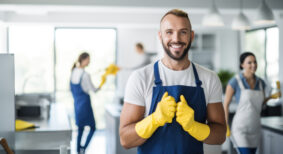There are few places that need to be more pristine than a clean room. Used for medical purposes or the assembly of items such as computer parts, even the smallest foreign particle can destroy an entire line of production of pharmaceuticals or microelectronics that rely on a clean manufacturing environment.
All clean rooms are sensitive to dust, vapours, airborne particles and other foreign matter. In these environments, the challenge is to maximize cleanliness and minimize contamination. This requires establishing and implementing best cleaning protocols, employing specially trained cleaning personnel, and using the right equipment, tools and supplies to safeguard and maintain the process or product yield.
SETTING THE STANDARD
Sanitation of clean rooms must meet stringent requirements that are aligned with good manufacturing practices (GMPs). Developed by government and regulatory bodies, these detailed, written procedures are followed to ensure products are consistently produced and controlled according to quality standards. If contamination occurs, the entire product batch will have to be quarantined or discarded. A single microscopic microbe can be the cause of recalls, delay in product delivery and ultimately the removal of product from store shelves.
SKILLED TO DELIVER
The most important factor for the successful implementation of any GMP is having educated and skilled staff. Cleaners need to be schooled on both preventative (regular) cleaning as well as emergency cleaning procedures. Training includes: introduction to basic microbiology; personnel conduct; equipment and materials flows; cleaning application methodologies; disinfection frequencies; cleaning and disinfecting agents; cleaning/disinfection logbooks; standard operating procedures; health and hygiene status; and clean room gowning requirements.
Depending on the industry, all employees should pass a medical clearance assessment as part of their training. As well, training should be ongoing, not a one-time event. An annual refresher course will go a long way to ensuring the highest standards of quality assurance are met and keep staff up-to-date on new cleaning methods, techniques and regulatory compliance.
GETTING INTO GEAR
To ensure a hygienic environment, cleaners must wear protective covering before entering a clean room and demonstrate proper gowning techniques. Once inside, only sterile tools can be used. Buckets, mops, jugs and wipes must be solely dedicated to the space and labelled as such to eliminate cross-contamination.
As an added precaution, all equipment and tools should be inspected before and after use for damage to guarantee cleaning efficacy. If damage-free, they should be cleaned, disinfected and properly stored after each use to protect them from future contamination. Live and non-live equipment should be stored separately, mop handles placed upright on custom racks and buckets set on shelves. All equipment and tools should also labelled according to where it is to be stored.
It’s important that staff follow a three-step cleaning application process that involves cleaning, disinfecting and sporicidal agents when sanitizing clean rooms. Cleaning agents are first used to remove chemical deposits, atmospheric pollutants and soils. Disinfecting and sporicidal agents are then applied to all surfaces to minimize bacterial hazards and eliminate the risk of product contamination.
While use and care of the appropriate equipment, tools and supplies is vital when working in clean rooms, all may be for naught if cleaning practices are not properly recorded in logbooks. Record-keeping is key to keeping in compliance with GMPs.
Peter Dellaportas is president of Kleenzone Ltd., a janitorial services company that specializes in commercial, industrial, clean room and good manufacturing practices (GMPs) cleaning. Established in 1985, Kleenzone has grown from a small family business into a successful full-service cleaning company with more than 300 employees across Canada. Peter can be reached at 1-866-209-6891 or pdellaportas@kleenzone.ca.









